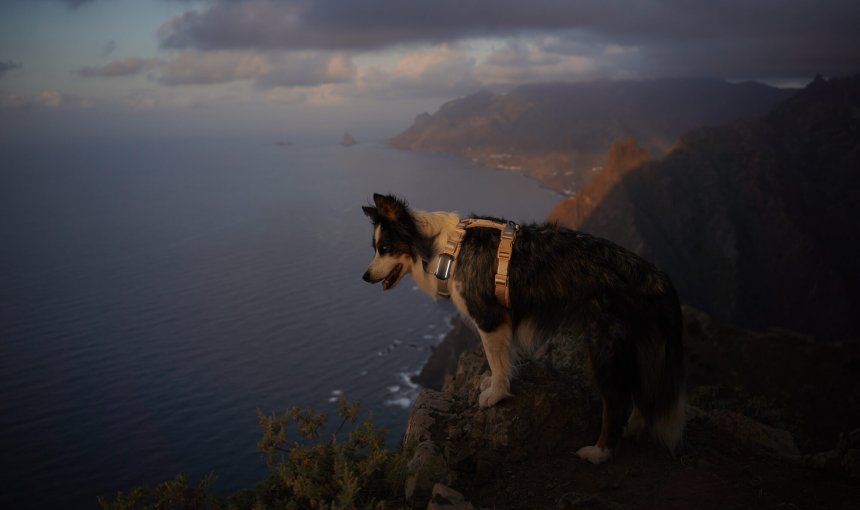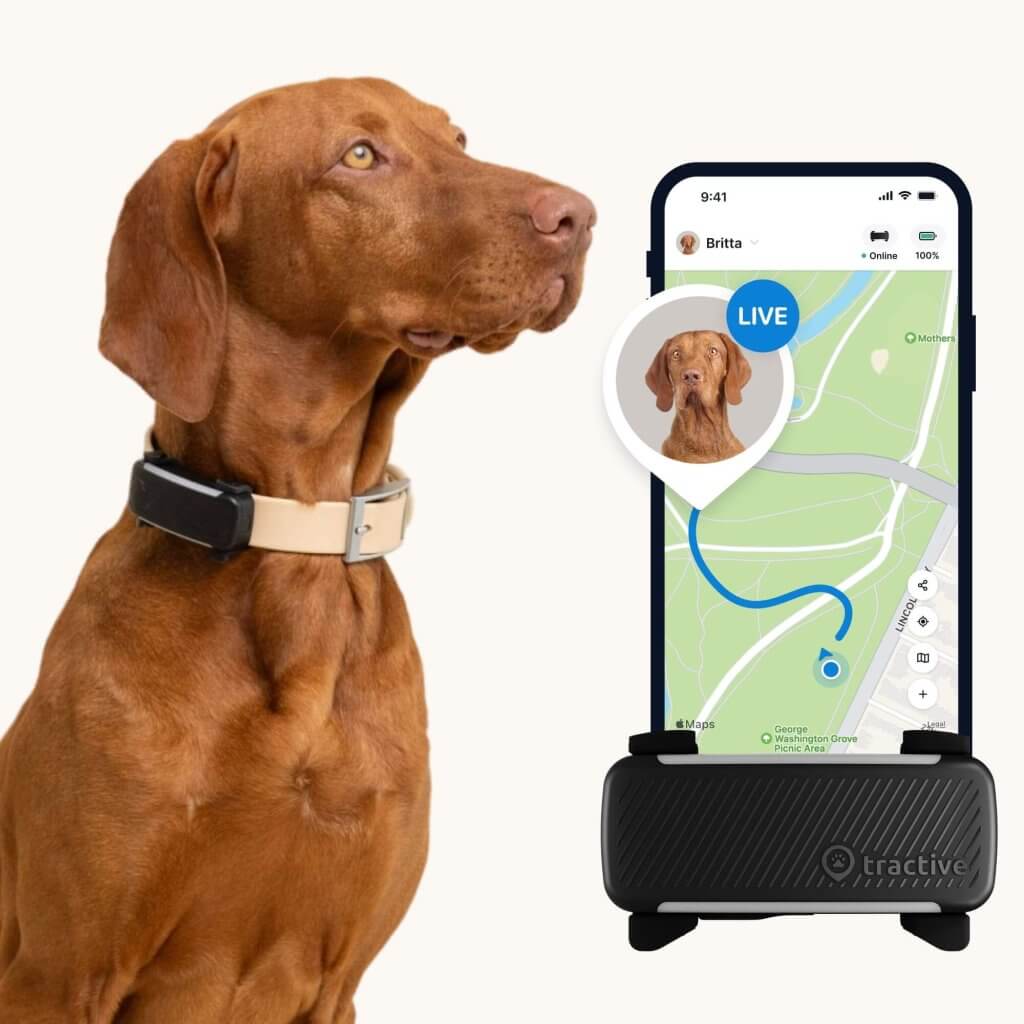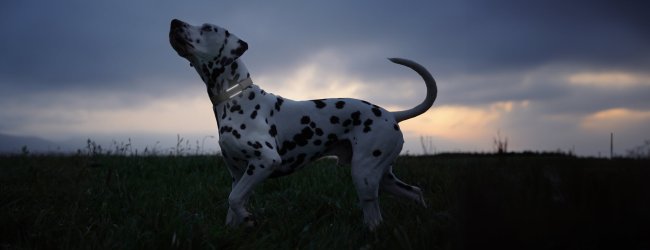What Do Dogs See at Night? Dog Night Vision Explained
Here's how dog night vision works, how it compares to human sight, & how tools like Tractive GPS can keep your pup safe after dark

Whether they’re sniffing around the backyard after dark or staring into the shadows on your nightly walk, you might be asking yourself: what do dogs see at night? Or even, do dogs have night vision? Let’s take a closer look at what your furry friend can (and can’t) see when the lights are out. (Plus, the #1 emergency measure you can take if they bolt off in the darkness.)
Key takeaways
🐶 Dogs can see in the dark much better than humans, thanks to their rod-rich retinas and the tapetum lucidum.
👩🏫 Understanding how your dog sees at night can help you train them better, understand their behavior, and keep them safe.
💡 Use reflective gear, lights, and leashes to stay visible and safe when walking your dog in the dark
🌎 A dog GPS tracker like Tractive adds an extra layer of safety with Light and Sound features, LIVE tracking, Virtual Fences, and Location History.
Can dogs see in the dark?
Yes, dogs can see in the dark – but not in the same way humans can. Dogs have evolved to detect movement and shapes in low-light environments far better than we can. This is thanks to some key differences in the way their eyes are built.
Dogs’ eyes contain more rod cells than human eyes. Rod cells are the photoreceptors responsible for vision in dim lighting. More rods mean better sensitivity to motion and light, which gives dogs an edge in the dark. Plus, dogs have a special reflective layer in their eyes called the tapetum lucidum. This acts like a mirror, bouncing light back through the retina and enhancing their ability to see in the dark. It’s also why your dog’s eyes might glow when you snap a flash photo at night!
Do dogs have night vision like cats?
While dogs don’t have night vision as strong as cats, they still see quite well in the dark. Cats are nocturnal hunters and have even more rods and a better tapetum lucidum than dogs do. But dogs still outperform humans by a mile when it comes to nighttime sight.
That said, dogs aren’t seeing in total darkness. They need at least a bit of ambient light to make sense of their surroundings. So, while they can navigate a dimly lit room or backyard, complete darkness is still challenging.
💡A dog GPS tracker with a built-in LED light can be a valuable emergency measure in case your buddy runs off to sniff out something in the darkness. We’ll cover it in detail a little further below.

Follow your dog anywhere
Get real-time location information, wherever they go. And find out when they try to make an escape, or just when they go somewhere they shouldn’t, with Virtual Fences.
Human vision vs. Dog vision at night
So, what do dogs see at night – and can they navigate in the dark? Turns out, they have some clear advantages over us. Here’s a breakdown to show how they stack up:
| Feature | Dogs | Humans |
|---|---|---|
| Low-light vision | Excellent | Poor |
| Motion detection | Very strong | Moderate |
| Color perception | Limited (blue and yellow) | Full color spectrum |
| Field of view | Wider (due to eye placement) | Narrower |
| Detail detection | Less sharp | More detailed |
| Tapetum lucidum | Present | Absent |
Dogs also have a higher flicker fusion rate than humans, meaning they can detect movement more clearly, especially in low light. While we might stumble around in dim conditions, dogs can confidently move through a room or down a dark path.
But this doesn’t mean they see everything perfectly at night. Only that they’re better equipped to navigate darkness than we are.
Why understanding your dog’s night vision matters
Understanding your dog’s night vision can help you make better decisions when the sun sets. Plus, it empowers you to work with them more effectively, whether you’re training, playing, or simply keeping them safe after dark.
Your dog relies heavily on motion to interpret the world. Thanks to the large number of rod cells in their retinas, dogs see moving objects much more clearly than stationary ones. In fact, motion sensitivity is considered one of the most important aspects of canine vision. This plays a big role in how they interact with you and the environment – especially at night. For example, during:
Night walks
Your dog may be more aware of subtle movements in the dark, like a squirrel in the bushes – which could lead to sudden leash tugs. Or even an escape attempt! If your dog barks or hesitates at night, they may be reacting to something they saw shift ever so slightly in the shadows – something you missed entirely. Likewise, If your yard isn’t fully enclosed, your dog might wander off chasing something they saw in the shadows.
Read more: Why Do Dogs Run Away? 6 Reasons Behind It
Training
Like, for example, for search and rescue dogs that go on nighttime missions. If you’re standing silently across the field from your dog, they might not recognize you just by sight. Your dog is far more likely to recognize you by your unique scent or a particular movement.1
Since so much of dog communication is based on posture and movement, even subtle body language becomes more important when visibility is limited. Small changes in posture – a wave of the hand, a step forward – can make a big difference in how your dog perceives and responds to you. That’s why trainers recommend using wide, sweeping motions when teaching dogs silent cues, especially in low-light conditions.
Fun activities you can do with your dog when it’s dark outdoors
If your dog enjoys being outdoors in the evening, here are a few nighttime activities that are both safe and entertaining:
- Glow-in-the-dark fetch
Use a glow-in-the-dark ball or toy to play a game of fetch in your backyard or a secure open space. Your dog will love chasing it, and you’ll both get in some extra exercise. - Sniff walks
Take your dog on a relaxed nighttime stroll focused on sniffing. With fewer distractions from other dogs and people, it’s a great time for your dog to engage their sense of smell – which is just as sharp at night. - Hide and seek (with treats or toys)
Hide treats or your dog’s favorite toy around your yard or home and let them sniff them out using their nose. This counts as a great mental workout that pairs perfectly with their night vision. - Light trail hikes
Head to a familiar trail with a flashlight or headlamp and explore nature together after dark. Just make sure your dog is always on-leash and wearing a comfortable harness. - Training games
Use nighttime as a calm setting to practice training commands or tricks in a quiet space. Use wide, sweeping gestures if working with visual cues – and reward your dog with lots of praise or treats. - Stargazing cuddles
Not every night needs to be active. Sometimes, lying down in the grass and stargazing with your pup curled up beside you is all the bonding you need.
Now let’s talk safety.
How you can keep your dog safe in the dark
Even with great night vision, your dog still faces challenges after sunset. Here are some safety tips to make nighttime adventures safer for both of you:
- Use high-visibility gear
Reflective collars, harnesses, and leashes make your dog easier to spot in the dark – by you, other people, and even drivers. - Bring a flashlight or wear a headlamp
While your dog may see fine, you probably don’t! A flashlight or headlamp helps you spot hazards like broken glass, uneven ground, or wildlife. - Choose well-lit walking routes
Whenever possible, stick to paths with streetlights or familiar trails where both you and your dog can walk with confidence. - Add a light-up accessory
An LED light on your dog’s collar or attached to their GPS tracker is a great way to make sure they’re always visible – even from a distance. - Keep your dog on-leash
No matter how well-trained they are, nighttime distractions can be unexpected. Keeping your dog leashed is the best way to avoid accidental run-offs. - Stay alert
Ditch the headphones and focus on your surroundings. Being fully aware can help you spot and respond to issues – before they become emergencies.
Following these simple tips, you’ll make nighttime walks not just safer – but a lot more enjoyable too.
Read more: 8 Steps To Safely Walk Your Dog In The Dark
When night vision isn’t enough (and where a dog GPS tracker can step in)
While dogs have impressive low-light vision, they can still lose their way in unfamiliar areas, especially if distracted or frightened. That’s where a dog GPS tracker with real-time tracking comes in handy. Tractive’s Light and Sound features let you locate your dog even when you can’t see them.
- With the Light feature, you can make their tracker blink in the dark – perfect for spotting them in the yard.
- And if they’re hiding nearby, the Sound feature can help guide them back with a gentle beep.

But that’s just the beginning. Strapped to your dog’s collar, your Tractive GPS also helps you:
- Follow your dog’s every step in real-time
LIVE Tracking helps you follow your dog’s movements – down to the slightest step, as they make their every step. So if they’ve run off after a nighttime critter, you’ll know exactly where they’re headed via the map on your mobile app. - Catch on to a nighttime escape attempt
From your app, you can set up a “safe zone” around your home or backyard. Now if your dog leaves the safe zone, you’ll get an immediate escape alert – day or night. - Retrace your dog’s steps and figure out their favorite spots
Via their Heat Map & Location History. This is especially helpful if they keep disappearing into the same shadowy part of the yard or woods. - Make finding your lost dog a team effort
Share your dog’s location via Family Sharing. This ensures that everyone’s on the same page during a nighttime search. Multiple people can track and help bring your pup home safely.
With these tools, Tractive doesn’t just support your dog’s natural night vision – it gives you a digital one too.
So, what do dogs see at night? Way more than us, that’s for sure. While they don’t have superhero-level night vision, they do see much better than we do in low light. Their unique eye structure helps them move confidently in the dark, but that doesn’t mean they’re immune to nighttime mishaps.
Pair their natural abilities with smart tech like the Tractive GPS, and you’ll have peace of mind no matter how dark it gets.



